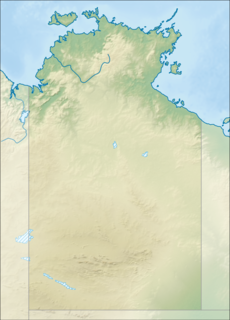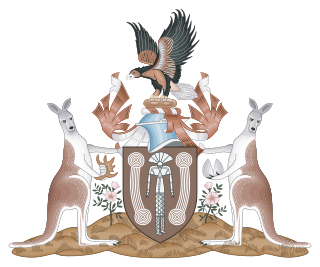Local government in the Australian state of South Australia describes the organisations and processes by which towns and districts can manage their own affairs to the extent permitted by section 64A of Constitution Act 1934 (SA).
Native title is the designation given to the common law doctrine of Aboriginal title in Australia, which is "the recognition by Australian law that Aboriginal people have rights and interests to their land that come from their traditional laws and customs". The concept recognises that in certain cases there was and is a continued beneficial legal interest in land held by local Aboriginal Australians which survived the acquisition of radical title to the land by the Crown at the time of sovereignty. Native title can co-exist with non-Aboriginal proprietary rights and in some cases different Aboriginal groups can exercise their native title over the same land.

Maralinga in the remote western areas of South Australia was the home of the Maralinga Tjarutja, a southern Pitjantjatjara people, an Aboriginal Australian people. Maralinga was the site of the British nuclear tests in the 1950s. The site measures about 3,300 square kilometres (1,300 sq mi) in area.

The Pitjantjatjara are an Aboriginal people of the Central Australian desert. They are closely related to the Yankunytjatjara and Ngaanyatjarra and their languages are, to a large extent, mutually intelligible.

The Pila Nguru, often referred to in English as the Spinifex people, are an Aboriginal Australian people of Western Australia, whose lands extend to the border with South Australia and to the north of the Nullarbor Plain. The centre of their homeland is in the Great Victoria Desert, at Tjuntjunjarra, some 700 kilometres (430 mi) east of Kalgoorlie, perhaps the remotest community in Australia. The Pila Nguru were the last Australian people to have dropped the complete trappings of their traditional lifestyle.

Kalka is a small Aboriginal community in the Anangu Pitjantjatjara Yankunytjatjara Lands in South Australia administered under the Anangu Pitjantjatjara Yankunytjatjara Land Rights Act 1981.

Oak Valley is the only community of Maralinga Tjarutja Aboriginal Council (AC) Local Government Area (LGA), South Australia. The population of the LGA was 105 people all in Oak Valley. It is approximately 128 km NNW of the original Maralinga township. It is named for the desert oaks that populate the vicinity of the community.

The Maralinga Tjarutja is the corporation representing the traditional Anangu owners of the remote western areas of South Australia known as the Maralinga Tjarutja lands. It is one of the four regions local government areas of South Australia classified as an Aboriginal Council (AC) and not incorporated within a local government area. This indigenous Australian people whose historic rights over the area have been officially recognised belongs to the southern branch of the Pitjantjatjara people. They have a community centre at Oak Valley, 520 miles NW of Ceduna, and close historical and kinship links with the Yalata 350km south, and the Pila Nguru centre of Tjuntjuntjara 370km to their west.

Musgrave Ranges is a mountain range in Central Australia, straddling the boundary of South Australia and the Northern Territory, extending into Western Australia. It is between the Great Victoria Desert to the south and the Gibson Desert to the north. They have a length of 210 kilometres (130 mi) and many peaks that have a height of more than 1,100 metres (3,600 ft), the highest being Mount Woodroffe at 1,435 metres (4,708 ft).

The Far North is a large region of South Australia close to the Northern Territory border. Colloquial usage of the term in South Australia refers to that part of South Australia north of a line roughly from Ceduna through Port Augusta to Broken Hill. The South Australian Government defines the Far North region similarly with the exception of the Maralinga Tjarutja Lands. the Yalata Aboriginal community and other unincorporated crown lands in the state's far west, which are officially considered part of the Eyre and Western region.

Milirrpum v Nabalco Pty Ltd was the first litigation on native title in Australia. The decision of Justice Richard Blackburn ruled against the claimants on a number of issues of law and fact, rejecting the doctrine of Aboriginal title recognizing that in the law of the time of British colonisation of Australia there was a distinction between settled colonies, where the land, being "desert and uncultivated", was claimed by right of occupancy, and conquered or ceded colonies. The term "desert and uncultivated" included territory in which resided "uncivilized inhabitants in a primitive state of society". The decision noted that the Crown had the power to extinguish native title, if it existed. The issue of terra nullius, later raised in Mabo v Queensland (1992), was not contemplated in this decision.
The Yirrkala bark petitions, sent by the Yolngu people of Arnhem Land to the Australian Parliament in 1963, were the first traditional documents prepared by Indigenous Australians that were recognised by the Australian Parliament, and the first documentary recognition of Indigenous people in Australian law. The petitions asserted that the Yolngu people owned land over which the federal government had granted mining rights to a private company, Nabalco.

James Yami Lester was a Yankunytjatjara man, an Indigenous person of northern South Australia. Lester, who survived nuclear testing in outback Australia, is best known as an anti-nuclear and indigenous rights advocate.

Aboriginal title is a common law doctrine that the land rights of indigenous peoples to customary tenure persist after the assumption of sovereignty under settler colonialism. The requirements of proof for the recognition of aboriginal title, the content of aboriginal title, the methods of extinguishing aboriginal title, and the availability of compensation in the case of extinguishment vary significantly by jurisdiction. Nearly all jurisdictions are in agreement that aboriginal title is inalienable, and that it may be held either individually or collectively.

The Outback Communities Authority (OCA) is a statutory authority in South Australia (SA) created under the Outback Communities Act 2009. It has been established to "manage the provision of public services and facilities to outback communities" which are widely dispersed across the Pastoral Unincorporated Area which covers almost 60% of South Australia's land area. The authority has its seat at both Port Augusta which is located outside the unincorporated area and at Andamooka. The authority serves an area of 624,339 square kilometres, slightly smaller than France. The area has a population of 3,750, of whom 639 are Indigenous Australians, and includes several large pastoral leases and mining operations.

Aṉangu Pitjantjatjara Yankunytjatjara is a large, sparsely populated local government area (LGA) for Aboriginal Australians, located in the remote north west of South Australia. Some of the aṉangu (people) of the Western Desert cultural bloc, in particular Pitjantjatjara, Yankunytjatjara and Ngaanyatjarra, inhabit the Lands.

The Anangu Pitjantjatjara Yankunytjatjara Land Rights Act 1981 grants certain land and other rights to the Anangu Pitjantjatjara Yankunytjatjara in South Australia. It began its life as the Pitjantjatjara Land Rights Act and commenced operation on 2 October 1981. Its long name title is "An Act to provide for the vesting of title to certain lands in the people known as Anangu Pitjantjatjara Yankunytjatjara; and for other purposes". The Act has since had several amendments, the latest in 2017.
Land councils, also known as Aboriginal land councils, or land and sea councils, are Australian community organisations, generally organised by region, that are commonly formed to represent the Indigenous Australians who occupied their particular region before the arrival of European settlers. They have historically advocated for recognition of traditional land rights, and also for the rights of Indigenous people in other areas such as equal wages and adequate housing.
Commonwealth, State, and Territory Parliaments of Australia have passed Aboriginal land rights legislation.
The Aboriginal South Australians are the Indigenous people who lived in South Australia prior to the British colonisation of South Australia, and their descendants and their ancestors. There are difficulties in identifying the names, territorial boundaries, and language groups of the Aboriginal peoples of South Australia, including poor record-keeping and deliberate obfuscation, so only a rough approximation can be given here.













